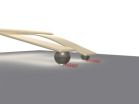HOUSTON, TX, September 01, 2012 (Press-News.org) Robert Kratschmer MD is one of very few practices in the Houston area offering Cellulaze, a revolutionary, minimally invasive treatment for cellulite. Since clinical trials only began three years ago, it is too early to say that results will be permanent, however it is extremely encouraging that results have already lasted for so long and there is every reason to assume that the effects will continue to be long lasting.
Cellulaze works by using a laser, first to destroy the composition of the cellulite and then to tighten and thicken the skin. Contrary to popular belief, cellulite is not something that is within your control to avoid or eliminate by diet and exercise; it is caused by a structural problem under the skin.
"Most cellulite treatments treat the problem superficially," says Houston plastic surgeon Dr. Robert Kratschmer. "Only Cellulaze treats the fibrous bands beneath the skin while simultaneously thickening the skin and improving elasticity. Cellulaze produces long-lasting results from just one treatment."
The procedure is performed under a local anesthetic and involves minimal downtime. Normal activities can usually be resumed within one or two days and strenuous exercise within one to two weeks. The procedure takes an hour to an hour and a half and costs in the region of $4,000, depending on the size of the area to be treated.
Clinical studies showed that a single Cellulaze treatment improves the appearance of cellulite for one year with minimal side effects. 93% of patients surveyed were satisfied or very satisfied with their results one year post-procedure, and all would recommend the treatment to a friend. Cellulaze was also shown to increase skin thickness by 25%, and skin elasticity by 29%, resulting in visibly smoother skin.
Patients looking for an effective cellulite treatment in Houston, or wishing to book an appointment, should visit http://MySurgeonForBeauty.com.
Robert Kratschmer MD Announces Revolutionary Treatment for Cellulite
Plastic surgeon announces new, minimally invasive procedure for treating cellulite.
2012-09-01
ELSE PRESS RELEASES FROM THIS DATE:
Affluent people less likely to reach out to others in times of trouble?
2012-08-31
Crises are said to bring people closer together. But a new study from the University of California, Berkeley, suggests that while the have-nots reach out to one another in times of trouble, the wealthy are more apt to find comfort in material possessions.
"In times of uncertainty, we see a dramatic polarization, with the rich more focused on holding onto and attaining wealth and the poor spending more time with friends and loved ones," said Paul Piff, a post-doctoral scholar in psychology at UC Berkeley and lead author of the paper published online this month in the Journal ...
Too much protein HUWE1 causes intellectual disability
2012-08-31
2 to 3 % of the children are born with an intellectual disability. Possibly by a genetic defect, but in 80% of these cases, we do not know – yet - which genes are responsible. VIB researchers at KU Leuven show that increased production of the HUWE1 protein is the cause in some patients.
Guy Froyen (VIB/KU Leuven): "The fact that HUWE1 regulates the dose of several other proteins in the brains, has an important impact on the quest for new therapies. It would then be possible to intervene in these different proteins. Research into the role of HUWE1 has already started ...
Breathable treatment to help prevent asthma attacks
2012-08-31
Details of a treatment that could help asthmatics fight infections that trigger 80% of asthma attacks, developed by University of Southampton spin-out company Synairgen, will be presented to European respiratory experts on Sunday 2 September.
The study provides the first evidence that boosting asthmatics' immune systems can help reduce the number of asthma attacks due to the common cold and other viral infections for the 5.4 million asthmatics in the UK.
Professor Ratko Djukanovic, a respiratory specialist at the University of Southampton and Southampton General Hospital, ...
Has osteoporosis treatment failed when a fracture occurs?
2012-08-31
The International Osteoporosis Foundation (IOF) has published practical guidelines to assist clinicians in assessing treatment efficacy in patients who experience a fracture while on medication for osteoporosis.
Osteoporosis drug therapy typically reduces the risk of fracture in the range of 30-70% for vertebral fractures, 40-50% for hip fractures and 15-20% for non-vertebral fractures. Nevertheless, even an effective therapy does not completely eliminate the risk of fracture, and some patients will experience a fracture while complying with their prescribed treatment. ...
Immune system protein could explain pancreatitis
2012-08-31
It is likely that the protein is also highly significant for other inflammatory diseases.
The research results have been published in the American journal Gastroenterology.
Excessive alcohol intake and gall stones are known risk factors for acute pancreatitis. However, as yet no explanation has been found for what actually happens in the body in cases of acute pancreatitis.
Current research shows that calcium-sensitive proteins found in the body, for example calcineurin, promote inflammation, but it is not known exactly how.
Henrik Thorlacius and Maria Gomez at the ...
Danish scientists solve old blood mystery
2012-08-31
Scientists at the research centre MEMBRANES at Aarhus University, Denmark, have completed an old puzzle, which since the 60s from many sides has been regarded as impossible to complete. The challenge was to solve the structure of the protecting protein complex that forms when haemoglobin is released from red cells and becomes toxic. This toxic release of haemoglobin occurs in many diseases affecting red cell stability, e.g. malaria.
Technically, the most important finding in this report in Nature is a high-resolution three-dimensional mapping of the so-called 'haptoglobin-haemoglobin ...
Glass shape influences how quickly we drink alcohol
2012-08-31
Dr Angela Attwood and colleagues from Bristol's School of Experimental Psychology recruited 160 social drinkers aged 18-40 with no history of alcoholism to attend two experimental sessions. At one session they were asked to drink either lager or a non-alcoholic soft drink from either a straight-sided glass or a curved 'beer flute'.
The participants were almost twice as slow when drinking alcohol from the straight-sided glass compared to the curved glass. There was no difference in drinking rates from the glasses when the drink was non-alcoholic.
The researchers suggest ...
Researchers develop new, less expensive nanolithography technique
2012-08-31
Researchers from North Carolina State University have developed a new nanolithography technique that is less expensive than other approaches and can be used to create technologies with biomedical applications.
"Among other things, this type of lithography can be used to manufacture chips for use in biological sensors that can identify target molecules, such as proteins or genetic material associated with specific medical conditions," says Dr. Albena Ivanisevic, co-author of a paper describing the research. Ivanisevic is an associate professor of materials science and ...
Fear and driving opportunity motivated changes in driving behavior after 9/11
2012-08-31
A catastrophic event – such as a terrorist attack, a natural disaster, or market collapse – often strikes twice. There is the damage caused by the event itself, as lives are lost or left in ruin. But there is also the second act, catalyzed by our response to the catastrophic event. This second act has the potential to cause just as much damage as the first.
In the year following the terrorist attacks of September 11, 2001, there were approximately 1,600 more traffic fatalities in the United States than expected. This figure suggests the possibility that fear may have ...
Research yields two 'firsts' regarding protein crucial to human cardiac function
2012-08-31
TALLAHASSEE, Fla. -- Florida State University researchers led by physics doctoral student Campion Loong have achieved significant benchmarks in a study of the human cardiac protein alpha-tropomyosin, which is an essential, molecular-level component that controls the heart's contraction on every beat.
Using an imaging method called atomic force microscopy, Loong achieved two "firsts": the first direct imaging of individual alpha-tropomyosin molecules, which are very small — roughly 40 nanometers long — and the first demonstrated examples of a measure of the human cardiac ...
LAST 30 PRESS RELEASES:
Making lighter work of calculating fluid and heat flow
Normalizing blood sugar can halve heart attack risk
Lowering blood sugar cuts heart attack risk in people with prediabetes
Study links genetic variants to risk of blinding eye disease in premature infants
Non-opioid ‘pain sponge’ therapy halts cartilage degeneration and relieves chronic pain
AI can pick up cultural values by mimicking how kids learn
China’s ecological redlines offer fast track to 30 x 30 global conservation goal
Invisible indoor threats: emerging household contaminants and their growing risks to human health
Adding antibody treatment to chemo boosts outcomes for children with rare cancer
Germline pathogenic variants among women without a history of breast cancer
Tanning beds triple melanoma risk, potentially causing broad DNA damage
Unique bond identified as key to viral infection speed
Indoor tanning makes youthful skin much older on a genetic level
Mouse model sheds new light on the causes and potential solutions to human GI problems linked to muscular dystrophy
The Journal of Nuclear Medicine ahead-of-print tip sheet: December 12, 2025
Smarter tools for peering into the microscopic world
Applications open for funding to conduct research in the Kinsey Institute archives
Global measure underestimates the severity of food insecurity
Child survivors of critical illness are missing out on timely follow up care
Risk-based vs annual breast cancer screening / the WISDOM randomized clinical trial
University of Toronto launches Electric Vehicle Innovation Ontario to accelerate advanced EV technologies and build Canada’s innovation advantage
Early relapse predicts poor outcomes in aggressive blood cancer
American College of Lifestyle Medicine applauds two CMS models aligned with lifestyle medicine practice and reimbursement
Clinical trial finds cannabis use not a barrier to quitting nicotine vaping
Supplemental nutrition assistance program policies and food insecurity
Switching immune cells to “night mode” could limit damage after a heart attack, study suggests
URI-based Global RIghts Project report spotlights continued troubling trends in worldwide inhumane treatment
Neutrophils are less aggressive at night, explaining why nighttime heart attacks cause less damage than daytime events
Menopausal hormone therapy may not pose breast cancer risk for women with BRCA mutations
Mobile health tool may improve quality of life for adolescent and young adult breast cancer survivors
[Press-News.org] Robert Kratschmer MD Announces Revolutionary Treatment for CellulitePlastic surgeon announces new, minimally invasive procedure for treating cellulite.

